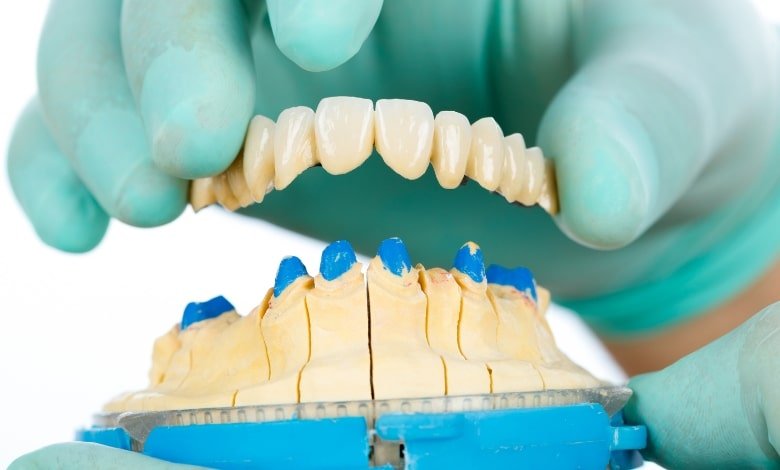Dental Bridges: A Solution For Missing Teeth

A dental bridge is a permanent prosthetic device used to replace one or more missing teeth. It consists of multiple components that are assembled to fit into the empty space left by the missing tooth or teeth. The purpose of a bridge is to enhance your ability to eat and speak, as well as improve the aesthetic appearance of your teeth. Dental bridges can be constructed from various materials, such as gold, alloys, or porcelain. Today, we will discuss the different types of dental bridges, their associated costs, benefits, and what you should expect if you are considering getting them.
Types of Dental Bridges
- Traditional fixed bridges: This is the most prevalent type of bridge. It typically involves placing a crown on each side of the synthetic tooth (the pontic) that replaces the missing tooth.
- Maryland dental bridges or resin-bonded bridges: It is primarily utilised for replacing front teeth. This type of bridge uses porcelain or metal frameworks with “wings.” The wings are bonded to the back of the adjacent teeth on either side of the gap instead of using crowns.
- Implant-supported bridges: This type of bridge requires the surgical placement of an implant for each missing tooth into the jawbone. The bridge contains the pontics and is placed over the implants in a subsequent procedure.
- Cantilever bridges: This type of bridge is less commonly used nowadays. It involves anchoring the pontic(s) on one side of the gap, using a single crown attached to the natural tooth present on that side.
Should You Get a Dental Bridge?
According to Dr. Gulay, one of Dentakay dentists, not everyone is an ideal candidate for a dental bridge, and it is crucial to consult with your dentist to determine if it is a suitable option for you. However, here are some factors which indicate that you may be a good candidate for a dental bridge:
- Missing one or more permanent teeth.
- Good overall health, without any significant medical conditions, infections, or health problems.
- Healthy teeth and a robust bone structure capable of supporting the bridge.
- Good oral health practices and the ability to perform proper oral hygiene to maintain the condition of the dental bridge.
Benefits of Dental Bridges:
Dental bridges offer several advantages, they include:
- Enhancing the natural appearance of your mouth and smile.
- Restoring normal speech patterns by addressing difficulties in word pronunciation caused by missing teeth.
- Preserving the facial structure’s regular shape by preventing jawbone loss at the site of the missing tooth or teeth.
- Improving chewing ability, leading to better digestion and nutrition.
- Preventing adjacent teeth from shifting into the empty space, thereby avoiding bite problems and potential complications.
Risks Associated with Dental Bridges:
While dental bridges have their benefits, it is important to be aware of potential disadvantages and risks, which include:
- Possibility of future damage to the abutment teeth, compromising the integrity of the bridge.
- Risk of bacteria and plaque accumulation inside ill-fitting bridges or crowns, leading to tooth decay.
- Altered tooth structure and potential impact on bite alignment due to the presence of crowns.
- Risk of bridge collapse if the abutment teeth lack sufficient strength to support it.
- Potential weakening of abutment teeth resulting from the dental bridge procedure, necessitating replacement with dental implants.
Process of Getting a Dental Bridge:
First, your dentist will need to take impressions or use a digital scan of your teeth, which will be used by a dental lab to fabricate the bridge components. For a cantilever dental bridge, the initial step will be to prepare the abutment teeth. Your dentist will then remove a portion of the enamel and dentin from these teeth to create space for the crowns. Subsequently, temporary bridges will be placed over the prepared teeth to protect them until the final bridge is ready.
After this, your dentist will remove the temporary crowns, verify the fit of the permanent crowns and bridge, and cement the bridge in place. Sometimes, the bridge is permanently cemented during this procedure. However, temporary cement may be used to allow for adjustments and ensure a proper fit before permanent cementation. Once the bridge’s fit is confirmed, your dentist will place it. He will then use a strong resin to bond the metal wings of the bridge to the abutment teeth.
For an implant-supported bridge, you will undergo a surgical procedure to place the implants into your jawbone. This will then be followed by recovery. The healing time for an implant-supported bridge varies. It is based on the location of the implants in your mouth and whether your jawbone requires augmentation to support the implants. During the healing phase, you may wear a temporary bridge until your next appointment. This is when the permanent bridge will be placed over the implants. This procedure involves minor incisions in the gums, resulting in a longer healing time compared to other types of bridges.
Caring for your Dental Bridge
Dental bridges are categorised as “permanent” because they cannot be removed like dentures. However, it is essential to note that a dental bridge has a limited lifespan. On average, a dental bridge lasts between five and seven years. However, with proper care, some bridges can endure for over a decade. Here are some tips for Prolonging the Lifespan of Your Dental Bridge:
- Maintaining good oral hygiene is vital when you have a dental bridge, as it helps preserve the strength and health of your natural teeth.
- Regular dental cleanings and check-ups are also crucial to ensure the bridge’s longevity.
- Avoid certain foods which may be damaging to your dentures.
What Foods Should You Avoid?
If you have a dental bridge, it is advisable to avoid certain types of food, including:
- Chewy or sticky candy that can potentially dislodge the crowns from the abutment teeth.
- Hard candy or snacks that may exert excessive pressure on the bridge.
- Sugary foods that can contribute to tooth decay beneath the crowns.
- Popcorn, which can get lodged in the bridge and cause discomfort.
- Nuts, as they can pose a risk of dislodging or damaging the bridge.
There are both advantages and disadvantages to getting a dental bridge. However, by practising good oral hygiene and maintaining regular dental visits, a dental bridge can serve as an effective and durable solution for missing teeth. If you have further inquiries or are considering a dental bridge, please don’t hesitate to book a consultation with us today.






